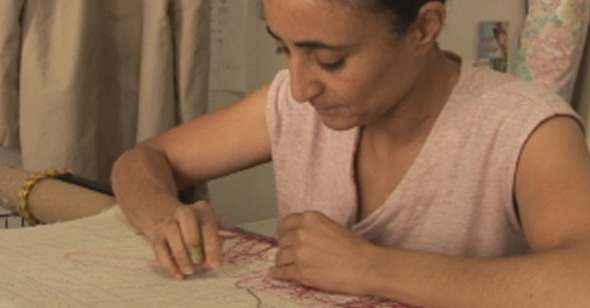Scene It
by Michael Joshua Rowin
Our City Dreams
Dir. Chiara Clemente, U.S., First Run Features
It hardly needs to be reiterated that New York City is the country’s—if not the world’s—most important breeding ground for art both low and high, but that’s pretty much the mission statement of Our City Dreams. Chiara Clemente’s documentary traces a backward chronology among five women from different generations who have all migrated to New York City to pursue a career as an artist. Starting with 31-year-old street artist Swoon, Clemente (whose previous credits include portraits of Frank Gehry and Jim Dine) documents the life and work of female artists born in each proceeding decade down to Nancy Spero, still going strong in her early eighties, with Egyptian abstract eroticist Ghada Amer, feminist Kiki Smith, and performance-art pioneer Marina Abramovic coming in between.
The idea is to have each artist’s work stand on its own while fashioning a mosaic of attitudes toward New York City. But while at the bare minimum Our City Dreams offers informative sketches that might pique the curiosity of those unfamiliar with the work of its subjects, beyond that, both the film’s understandably divided structure (unlike the singularly focused Louise Bourgeois: The Spider, the Mistress, and the Tangerine) and its unaccountably ADD editing (a Swoon exhibition seemingly overrun by street punks is sloppily assembled and given no context) prevent the art from being explored or even seen in depth, while the main thematic thread—several generations of female artists forging their paths in New York City—remains obscure.
Clemente makes it clear that conditions and options for women have changed—for example, between mother and surviving matriarch Spero’s pioneering activist efforts for feminist artists in the Sixties and Seventies, when the scene was more patriarchal and male-dominated, and Swoon’s awareness that at present “being a female artist is encouraged” and that she’s “too consumed by art to start a family”—but reasons why and how such changes have occurred never come through in interviews with subjects asked to relate the specific trajectory of their own careers.
Furthermore, New York City is not approached from a single new angle. Here it’s just the art capital of the world, possessing a ineffable electricity, and so on. The backward chronology presents problems in this sense: the film’s inability to account for New York’s sizable cultural, economic, and architectural developments starting from the Sixties—when Spero returned from Paris with artist-husband Leon Golub—has thus taken them for granted. For instance, Swoon’s description of relocating to the Big Apple to observe and capture moments of urban anonymity and kineticism sets the tone for NYC’s depiction as possessing a vague “energy” that attracts artists of diverse background. Amer’s dripping embroideries and ironic collages express her unique vantage point between the Muslim culture in which she grew up and the Western society she has made her home, but we only learn that as an outsider she enjoys working in New York because it’s a city “where no one fits in.” Even Marina Abramovic, a Yugoslavian ex-pat, simply calls the city “the only major metropolis for making art.”
How New York at first appeared and continues to appear in all its rich detail to these people who had grown up an ocean and culture away is kept a mystery. “New York City really has it all,” Joey Ramone once monotoned, and that’s more or less the impression one comes away with from Our City Dreams, except without the sense of excitement, danger, and complexity that might inspire others to discover it for themselves.
